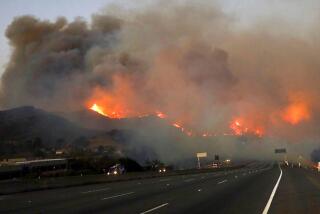Laguna Beach May Use Goats on Firebreaks
- Share via
LAGUNA BEACH — City officials, tired of depending on human solutions to maintain firebreaks necessary for protection of the community’s pristine hillsides, voted Tuesday to consider hiring up to 800 goats for the job.
“I’m very interested in saving the people of Laguna Beach thousands of dollars,” said Councilman Robert F. Gentry, “but we have to work through the environmental questions.”
If an agreement is reached with state and county officials on environmental issues as well as sharing the costs, the goats would work on about 12 miles of firebreaks around the perimeter of the seaside colony. The goats would be helped by shepherds, dogs, horses and occasional hand crews.
“This is a natural program,” goatherder Ken McWilliam said from his Los Angeles station Tuesday afternoon. “It’s an art and a science.”
But Laguna Beach residents Tuesday night said they feared goats would ravage the landscape, import lime disease, get loose or breed uncontrollably.
The council voted to study the environmental issues before making a final decision. Because the land abuts county and state land, city officials want those governments to share the costs.
McWilliam said he has had goatherds working in Topanga Canyon and in Northern California. Laguna Beach Deputy Fire Chief Richard Dewberry visited the herder and his goats last December. Now he wants them in Laguna Beach.
“I was very impressed,” Dewberry said. “He has so much experience that he can do things (with goats) that I never knew could be done.”
Dewberry said the goal is not to clear all growth but to “feather,” or reduce the amount of fuel for fires.
“Goats can do that when used properly,” he said. “It’s all a matter of timing.”
McWilliam said his goats are bred for jobs like this.
“They can eat as much as a cow, but they don’t pull out the roots,” he said. “They prune, rather than destroy. And they can eat a lot of poison plants that would knock a domestic goat right out.”
The Laguna Beach move toward goat recruitment is the latest step in a history of efforts to maintain firebreaks that were originally constructed in the ‘50s and ‘60s by California Department of Forestry and Orange County Fire Department crews made up of jail inmates, Dewberry said before the meeting.
“In the early ‘60s, political and philosophical opposition to the breaks began to mount,” Dewberry said. “Awareness (about fire danger) wasn’t as good as it is today. People didn’t like to look at firebreaks and inmate crews.”
By 1981, only traces of the breaks remained, but by then people had again rallied to the necessity of fire protection.
In 1982, state and county crews began to reinstall the breaks, Dewberry said. Now, firebreaks exist from Emerald Canyon to Laguna Canyon, from the Alta Laguna Park to Moulton Meadows and intermittently south to about the middle of South Laguna.
Dewberry said those efforts are commendable but insufficient for the never-ending job.
“The biggest problem is to do it more efficiently, more cost-effectively and to get the job done,” he said. “The inmate crews are great, but there are just not enough to go around. And other crews are spread thin and are hard to keep in one place for long-term projects because of demands from other services.”
Goats are cheaper, too.
Dewberry said goats and related equipment cost from $600 to $800 an acre. Figures from the California Department of Forestry cite a manpower cost of $800 to $1,800 per acre, he said.
“If this plan goes, we would hire McWilliam, who already has the goats,” he said. “People have been talking about using Catalina goats, but they have to be trapped and transported. That presents a logistical problem.”
Dewberry also said the wild Catalina goats could die being trapped. “The goats we would use will be fenced at night for protection from wild animals,” he said. “We’re looking at areas near breaks which would work for that.”
Dewberry stressed that environmental concerns would be addressed.
“People actually see deer grazing better (than before the break) once the grass grows in,” he said. “And we will make them as attractive as possible and be very sensitive to rare and endangered species of plants.”
Dewberry said he has an appointment with state fire officials later this month to discuss the proposal.
More to Read
Sign up for Essential California
The most important California stories and recommendations in your inbox every morning.
You may occasionally receive promotional content from the Los Angeles Times.










